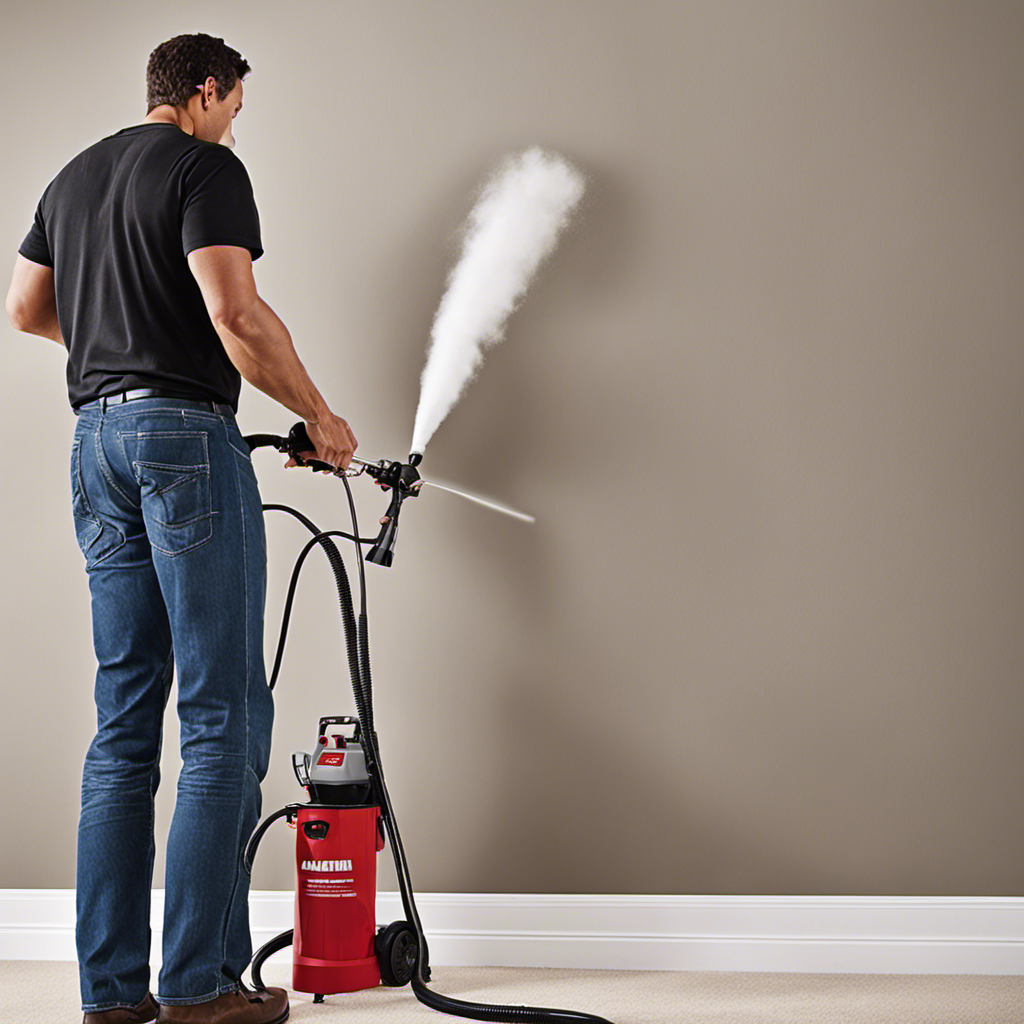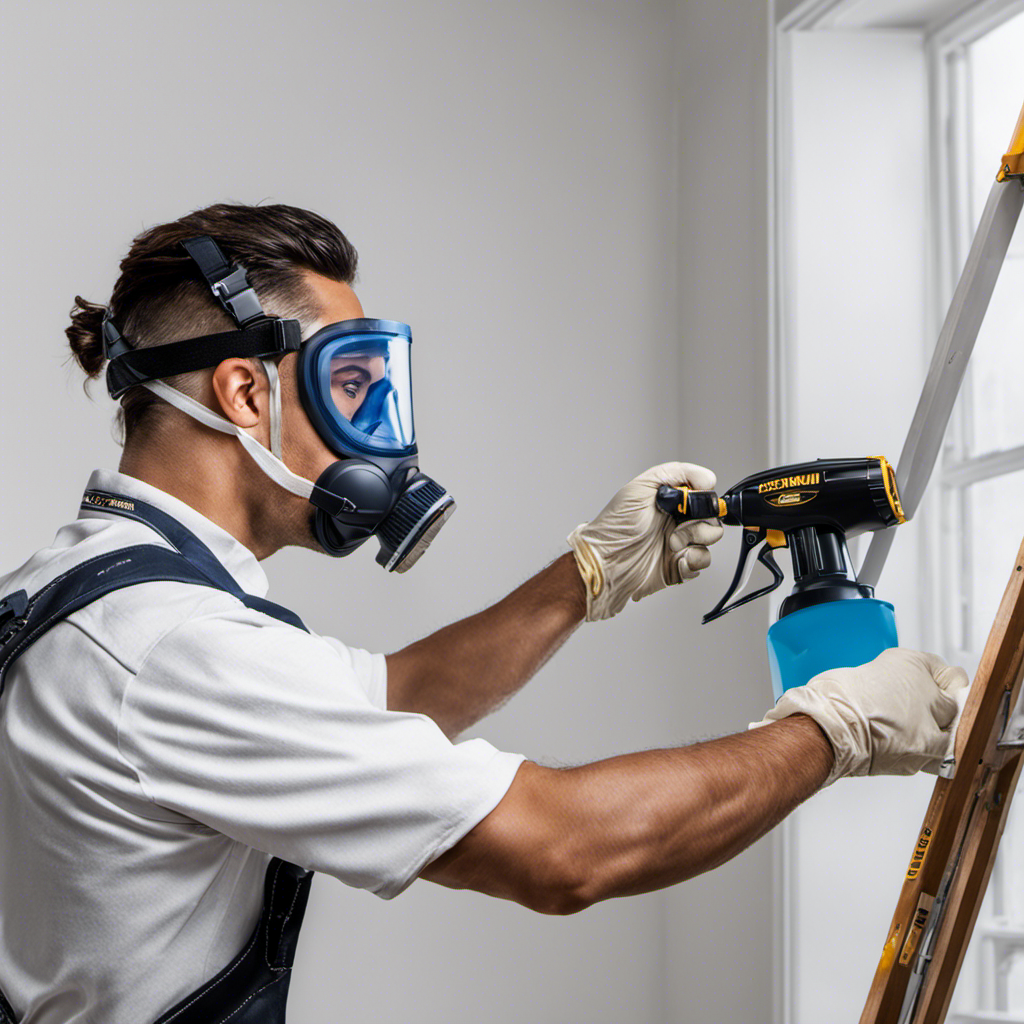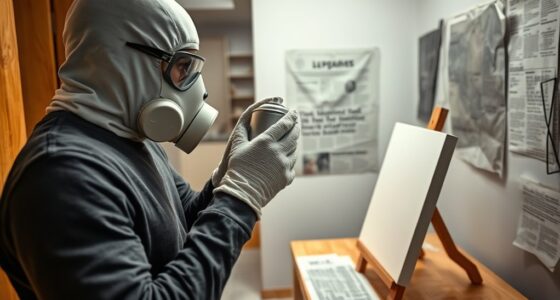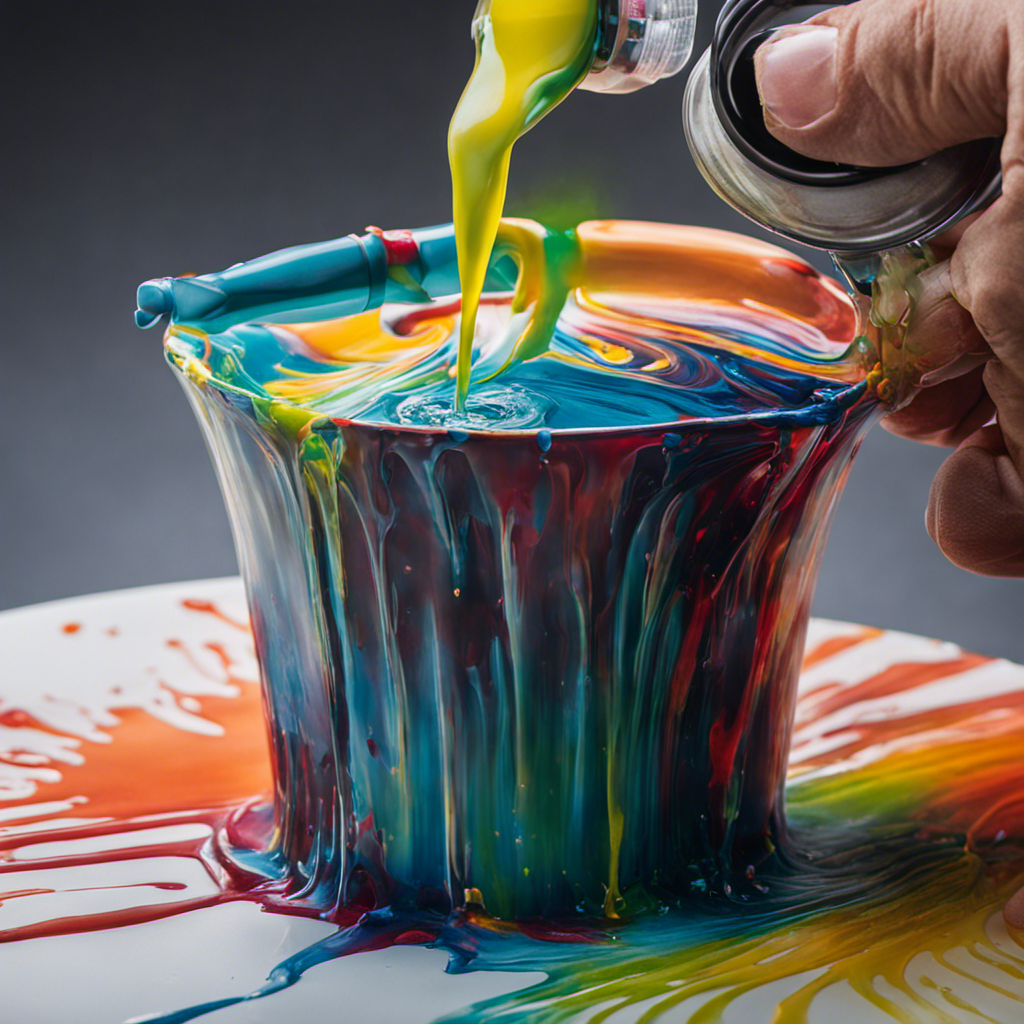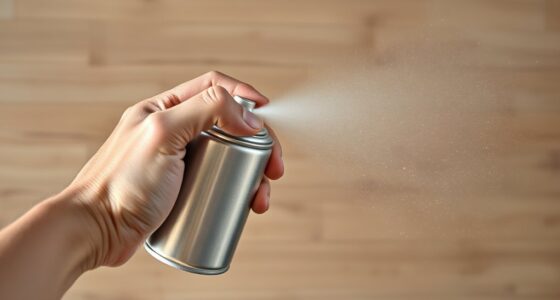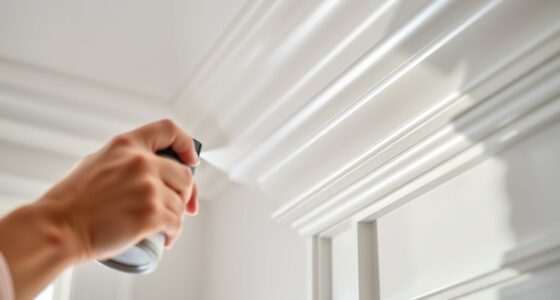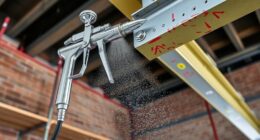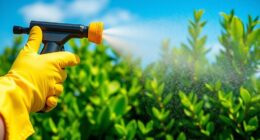Mastering the right techniques is essential in achieving a flawless finish with an airless paint sprayer.
Imagine painting a room and noticing thin, uneven lines of paint known as tails ruining the look. By holding the sprayer nozzle at the proper distance from the surface, maintaining a steady speed, and ensuring a consistent overlap between each stroke, these issues can be avoided.
Adjusting the pressure settings, choosing the right nozzle size, and troubleshooting common problems are also crucial for a flawless result.
Key Takeaways
- Proper technique is crucial to avoid creating tails and achieve a smooth finish.
- Maintain a consistent speed, distance, and overlap when using an airless paint sprayer.
- Use multiple thin coats instead of one thick coat for better control and coverage.
- Adjust pressure settings and choose the right nozzle size based on the paint type and desired finish.
Understanding How an Airless Paint Sprayer Works
An airless paint sprayer propels paint with force, creating a smooth finish. This method of painting offers several advantages over traditional brush or roller techniques.
Airless sprayers allow for a faster application of paint, saving both time and effort. They also provide a more even coverage, reducing the likelihood of streaks or brush marks.
However, there are common mistakes that should be avoided when using an airless paint sprayer. One such mistake is creating ‘tails’ – thin, uneven lines of paint. This can be prevented by mastering the proper technique, which includes holding the sprayer nozzle at the correct distance from the surface, maintaining a steady speed, and ensuring consistent overlap between each stroke.
Proper Paint Application Techniques
To achieve a consistent and even application of paint, one must hold the sprayer nozzle at a distance of 8-12 inches from the surface. Proper paint application techniques are essential for achieving a glossy finish and ensuring that the paint dries properly. Maintaining a steady speed while moving the sprayer across the surface is crucial. It is important to ensure a consistent overlap of about 50% between each stroke to avoid thick areas and drips. Additionally, using multiple thin coats instead of one thick coat helps to achieve a smoother finish. Applying a primer before painting can also improve adhesion and create a smooth surface for the paint. By following these techniques, one can achieve professional results and a beautiful glossy finish.
| Proper Paint Application Techniques |
|---|
| – Hold sprayer nozzle 8-12 inches from surface |
| – Maintain a steady speed while moving sprayer |
| – Ensure consistent 50% overlap between strokes |
| – Use multiple thin coats instead of one thick coat |
| – Apply a primer before painting |
Hold the Sprayer Nozzle at the Right Distance
The user should hold the sprayer nozzle at the correct distance from the surface to achieve an even application of paint. Achieving consistent spray patterns and preventing drips and runs are key goals when using an airless paint sprayer.
Holding the sprayer nozzle at a distance of 8-12 inches from the surface is recommended. This distance allows for better control and helps in maintaining a consistent spray pattern. Holding the sprayer too close can cause excessive build-up of paint, leading to drips and runs. On the other hand, holding it too far away can result in thin and inconsistent coverage.
Maintain a Steady Speed While Moving the Sprayer
Maintaining a steady speed while moving the sprayer across the surface ensures an even and consistent application of paint. This is crucial for achieving a smooth finish with an airless paint sprayer.
To maintain a consistent speed, consider the following tips:
- Find a comfortable and balanced stance to ensure stability and control.
- Start the sprayer before reaching the surface to avoid buildup of paint in one spot.
- Use smooth and fluid motions while moving the sprayer, avoiding sudden stops or jerky movements.
- Practice maintaining a steady pace, neither too fast nor too slow, to ensure the paint is applied evenly.
Ensure Consistent Overlap Between Each Stroke
Consistency in the overlap between each stroke is important to ensure an even and uniform distribution of paint. Achieving a seamless blend between each stroke is crucial for a smooth finish. It helps to eliminate any noticeable lines or marks that can occur when the strokes are not properly blended. Ensuring a uniform distribution of paint coverage is also essential. This means that each stroke should cover the surface evenly, without any areas that are missed or have too much paint. To achieve this, painters should maintain a steady speed while moving the sprayer across the surface and maintain a consistent overlap of about 50% between each stroke. By following these techniques, painters can achieve a professional and flawless finish.
| Discussion Ideas |
|---|
| Achieving a seamless blend between each stroke |
| Ensuring a uniform distribution of paint coverage |
Avoid Overlapping Too Much or Too Little
Achieving an even distribution of paint coverage requires painters to avoid overlapping too much or too little while using an airless paint sprayer. This is essential to avoid drips and runs and to achieve even coverage with multiple thin coats.
To achieve optimal results, painters should follow these guidelines:
- Maintain a consistent speed throughout the painting process to prevent uneven coverage.
- Hold the sprayer nozzle at a distance of 8-12 inches from the surface.
- Ensure a consistent overlap of about 50% between each stroke to avoid gaps and uneven coverage.
- Use multiple thin coats instead of one thick coat to achieve a smooth finish.
Maintain a Consistent Speed Throughout the Process
To ensure an even distribution of paint, painters should maintain a steady speed throughout the process when using an airless paint sprayer. Maintaining a consistent speed is of utmost importance to achieve a smooth and even application of paint. Moving too quickly can result in uneven coverage, while moving too slowly can lead to drips and runs.
By maintaining a steady speed, painters can ensure that the paint is applied evenly across the surface, avoiding any streaks or uneven areas. Additionally, it is important to maintain a consistent distance between the sprayer and the surface being painted to achieve optimal results.
Use Multiple Thin Coats Instead of One Thick Coat
Using multiple thin coats instead of one thick coat is recommended to achieve a more even and durable application of paint with an airless paint sprayer. This technique allows for better control and a smoother distribution of paint.
To improve the finish, consider using a paint conditioner, which can reduce imperfections and enhance the overall appearance of the painted surface.
Additionally, it is important to properly adjust the pressure settings on the sprayer to ensure a smooth and impressive finish. Proper pressure adjustment is key in achieving a consistent flow of paint and preventing uneven application.
Apply a Primer Before Painting
Applying a primer before painting helps create a smooth surface for the paint and improves adhesion for a durable finish. When choosing the appropriate paint color, it is essential to consider the type of surface and the desired outcome.
To achieve a flawless finish, here are some tips to follow. Firstly, ensure the surface is clean and free from any dirt or debris. Use a high-quality primer that is compatible with the paint you will be using. Apply the primer evenly and allow it to dry completely before starting the painting process. This will help create a uniform base and enhance the adherence of the paint.
Additionally, consider using a paint conditioner to reduce imperfections and achieve a smoother finish. By following these tips, you can achieve a flawless and professional-looking paint job.
Consider Using a Paint Conditioner
A paint conditioner can be helpful in reducing imperfections and achieving a smoother and more professional-looking paint job. Some benefits of using a paint conditioner include:
- Improved paint flow and leveling: A paint conditioner helps to thin the paint and improve its flow, reducing brush marks and uneven texture.
- Enhanced adhesion: The conditioner helps the paint adhere better to the surface, ensuring a longer-lasting finish.
- Minimized brush strokes and roller marks: By improving the paint’s flow, a conditioner helps to minimize visible brush strokes and roller marks.
- Reduced drying time: The conditioner can speed up the drying time of the paint, allowing for quicker completion of the project.
To achieve a flawless finish with a paint conditioner, consider the following tips:
- Follow the manufacturer’s instructions on the proper ratio of conditioner to paint.
- Mix the conditioner thoroughly into the paint to ensure even distribution.
- Apply the paint with smooth and consistent strokes, using the appropriate brush or roller.
- Allow sufficient drying time between coats to prevent smudging or streaking.
Adjusting the Pressure Settings for a Smooth Finish
The user can achieve a more consistent and even application of paint by adjusting the pressure settings on the sprayer. Pressure adjustment techniques are essential for a smooth finish.
By considering the paint viscosity and testing pressure settings on a sample surface, the user can ensure consistent flow and prevent uneven application.
It is important to watch out for pressure fluctuations caused by clogs or worn parts. Troubleshooting nozzle clogs is crucial for maintaining optimal performance.
Checking for paint clogs in the spray gun or hose, cleaning the nozzle, and using the correct tip size for the type of paint and desired finish can help prevent issues.
Choosing the Right Nozzle Size for Your Project
When choosing a nozzle size for a project, it is important to consider the type of surface and desired spray pattern. The right nozzle size can greatly impact the quality and efficiency of the paint application. Here are some key factors to keep in mind:
-
Choosing the right paint type: Different paints have different viscosities, and using the appropriate nozzle size for each type can prevent nozzle clogs and ensure a smooth finish.
-
Troubleshooting nozzle clogs: Nozzle clogs can occur due to various reasons, such as paint buildup or debris. Regularly inspecting and cleaning the nozzle can help prevent clogs and maintain optimal performance.
-
Optimal spray pattern: The desired spray pattern should also be considered when selecting a nozzle size. Different projects may require different patterns, such as a narrow fan for precise work or a wide fan for larger surfaces.
-
Professional results: By choosing the right nozzle size, you can achieve precise and professional results, with even coverage and minimal overspray.
Troubleshooting Common Issues and Cleaning the Sprayer
After choosing the right nozzle size for your project, it’s important to be prepared for any troubleshooting that may arise during the painting process.
One common issue that can occur is nozzle clogs. To troubleshoot nozzle clogs, it is essential to clean the sprayer properly. Begin by checking for paint clogs in the spray gun or hose and clean the nozzle thoroughly.
Adjusting the pressure can also help reduce overspray and achieve a controlled spray pattern. Additionally, using the correct tip size for the type of paint and desired finish is crucial.
To maintain optimal performance, it is necessary to clean the sprayer after each use by flushing it with water or a cleaning solution. Regularly inspecting and maintaining the sprayer’s components, such as the filters, spray tip, pump, hoses, and connections, will help prevent issues and ensure a professional finish.
Maintaining the Sprayer for Optimal Performance
To ensure optimal performance, regular maintenance of the sprayer is necessary. Cleaning techniques and preventing nozzle clogs are essential for maintaining the sprayer and achieving a smooth finish. Here are four important tips to keep in mind:
- Clean the sprayer after each use by flushing it with water or a cleaning solution.
- Pay attention to cleaning the filters and removing debris to prevent clogs.
- Check the spray tip for any clogs or build-up and clean or replace it as needed.
- Regularly lubricate the pump to prevent issues with the piston or packing.
Frequently Asked Questions
How Do I Prevent Tails From Appearing When Using an Airless Paint Sprayer?
To prevent tails when using an airless paint sprayer, the user should ensure proper technique and equipment maintenance. Hold the sprayer nozzle at the recommended distance from the surface and maintain a consistent speed and overlap between strokes.
Check for any clogs or worn parts that may cause pressure fluctuations and adjust the pressure accordingly. Choosing the correct nozzle size for the paint type and surface is also crucial.
Regularly clean and maintain the sprayer to prevent issues that could lead to streaks.
What Is the Recommended Distance Between the Sprayer Nozzle and the Surface Being Painted?
The recommended distance between the sprayer nozzle and the surface being painted is typically 8-12 inches. This distance allows for proper paint coverage and prevents excessive build-up or thin and inconsistent coverage.
It is important to maintain a consistent distance throughout the painting process to achieve a smooth finish. Proper surface preparation, such as cleaning and priming, is also crucial for optimal paint adhesion and a professional result.
How Do I Choose the Right Paint Type to Avoid Nozzle Clogs?
To avoid nozzle clogs, it’s important to choose the right paint type for your project. Consider the surface you’re painting and select a paint that is compatible. For example, use latex paint for walls and oil-based paint for trim. This will help prevent clogs and ensure a smooth finish.
Additionally, to prevent paint splatters and drips, make sure to use thin coats and maintain a consistent speed and distance while spraying. These tips will help you achieve a professional-looking result.
What Should I Do if I Encounter Overspray While Using an Airless Paint Sprayer?
When encountering overspray while using an airless paint sprayer, there are several techniques and solutions to deal with it.
First, adjusting the pressure settings can help reduce overspray and achieve a controlled spray pattern.
Another solution is to use a smaller nozzle size, which can provide more precision and reduce overspray.
Additionally, maintaining a consistent distance between the sprayer and the surface being painted can help minimize overspray.
How Often Should I Clean and Maintain My Airless Paint Sprayer to Ensure Optimal Performance?
Cleaning and maintaining an airless paint sprayer regularly is essential for optimal performance. Neglecting this task can lead to clogs and decreased efficiency, so it’s important to take the time to do it.
To ensure smooth operation, it’s recommended to clean the sprayer after each use. This includes inspecting hoses, filters, and connections for any damage. Regular maintenance also includes lubricating the pump and checking the spray tip for clogs or build-up.
Following these cleaning frequency and maintenance tips will help keep your airless paint sprayer in top condition.
Conclusion
In conclusion, mastering airless paint sprayer techniques is essential for achieving a smooth finish. By understanding how the sprayer works and following proper paint application techniques, one can avoid common issues such as tails and uneven lines.
Holding the sprayer nozzle at the right distance, maintaining a steady speed, and ensuring a consistent overlap between each stroke are key factors in achieving a flawless result. Adjusting pressure settings, choosing the right nozzle size, troubleshooting issues, and regular maintenance are also crucial.
Just like a skilled artist with a brush, mastering these techniques will help you create a finish as smooth as silk.
Franz came aboard the Paint Sprayer Zone team with a background in both journalism and home renovation. His articulate writing style, combined with a passion for DIY projects, makes him an invaluable asset. Franz has a knack for breaking down technical jargon into easy-to-understand content, ensuring that even the most novice of readers can grasp the complexities of paint sprayers.
